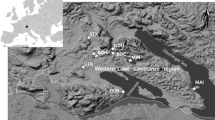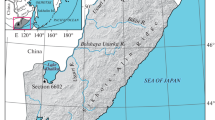Abstract
Lago do Pires (17° 57′ S, 42° 13′ W) is situated at 390 m a.s.l. in the foothills of the Serra do Espinhaço, 250 km from the Brazilian Atlantic coast. The original vegetation of the study area has been almost destroyed by pastoral activity. Relicts of a dense 20–30 m tall tropical semidciduous forest are present only on a few hill tops. The dry season of the Lago do Pires region lasts for 4 months and the annual precipitation is 1250 mm. A high resolution pollen record from a 16 m long sediment core, composed of 77 samples, subdivided in 7 zones and 4 subzones, allows a reconstruction of Holocene paleoenvironments. For the early Holocene (9720-8810 B.P.), the results indicate that the region surrounding the lake was dominated by a herb savanna (campo cerrado) withCuratella americana (cerrado tree) and high fire frequency. Species ofCecropia, Urticales and a few others, form small gallery forests along the water courses. This vegetation pattern is consistent with a long dry season (perhaps 6 months) and a low annual precipitation. Between 8810 and 7500 years B.P. gallery forests expanded in the valleys and suggest a period of higher rainfall with shortened dry season (perhaps 5 months). Fire was less frequent. Reduction of gallery forests followed (7500-5530 B.P.), probably related to a return of drier climatic conditions (5–6 months dry season, lower precipitation). Fires were more frequent. Between 5530 and 2780 years B.P. in the vallyes were forests and on the hills still an open cerrado. The dry season probably was about 5 months and the rainfall was higher than in the previous period. Later (2780-970 B.P.) the more open cerrado on the hills changed to more closed cerrado. A dense and closed semideciduous forest existed in the region only in the latest Holocene period (since 970 B.P.) under the current climatic conditions. The vegetation was no longer influenced by fire. A very strong human impact by deforestation and use of fire occurred in the last decades. Today cerrado vegetation is generally restricted to central Brazil and exists in several small isolated ‘Islands’ (Hueck, 1956) in the area of semideciduous forest in SE Brazil which were more widespread during the drier periods of the Holocene. The wettest period of Holocene occurs in the present millenium.
Similar content being viewed by others
References
Absy, M. L., 1979. A palynological study of Holocene sediments in the Amazon Basin. Ph.D. Thesis, University of Amsterdam: 86 pp.
Andrade-Lima, D. de, 1953. Notas sobre a dispersão de algumas espécies vegetais no Brasil. Anais Sociedade Biologica Pernambuco 11: 25–49.
Bahn, P. G., 1993. 50,000-year-old Americans of Pedra Furada. Nature 362: 114–115.
Behling, H., 1993. Untersuchungen zur spätpleistozänen und holozänen Vegetations- und Klimageschichte der tropischen Küstenwälder und der Araukarienwälder in Santa Catarina (Südbrasilien). Dissertationes Botanicae, Band 206, J. Cramer, Berlin, Stuttgart: 149 pp.
Berg, C. C., 1977. Brief Communication, Abscisison of anthers inCecropia Loefl. Acta Bot. Neerl. 26: 417–419.
Beug, H.-J., 1957. Untesuchungen zur spätglazialen und frühpostglazialen Floren- und Vegetationsgeschichte einiger Mittelgebirge (Fichtelgebirge, Harz und Röhn). FLora 14: 167–211.
Cole, M. M., 1960. Cerrado, caatinga and pantanal: distribution and origin of the savanna vegetation of Brazil. Geographical Journal 126: 168–179.
Cole, M. M., 1982. The influence of soils, geomorphology and geology on the distribution of plant communities in savanna ecosystems. In Huntley, B. J. & B. H. Walker (eds), Ecology of Tropical Savannas. Ecological Studies 42, Springer, Berlin, Heidelberg, New York, Tokyo: 145–174.
Cole, M. M., 1986. The savannas: Biogeography and geobotany. Academic Press, London: 438 pp.
Colinvaux, P. A., 1987. Amazon diversity in the light of the paleoecological record. Quat. Sci. Rev. 6: 93–114.
Colinvaux, P. A., 1989. Ice Age Amazon revisited. Nature 340: 188–189.
Colinvaux, P. A., 1993. Pleistocene biogeography and diversity in tropical forests of South America. In Goldblatt, P. (ed.), Biological relationships between Africa and South America. Yale University Press, New Haven, London: 473–499.
Coutinho, L. M., 1982. Ecological effects of fire in Brazilian cerrado. In Huntley, B. J. & B. H. Walker (eds), Ecology of Tropical Savannas. Ecological Studies 84, Springer, Berlin, Heidelberg, New York, Tokyo: 82–105.
De Oliveira, P. E., 1992. A palynological record of late Quaternary vegetational and climatic change in southeastern Brazil. Ph.D. Thesis, The Ohio State University, Columbus: 238 pp.
Eiten, G., 1972. The cerrado vegetation of Brazil. Botanical Review 38: 205–341.
Eiten, G., 1975. The vegetation of the Serra do Roncador. Biotropica 7: 112–135.
Eiten, G., 1982. Brazilian ‘savannas’. In Huntley, B. J. & B. H. Walker (eds), Ecology of Tropical Savannas. Ecological Studies 42, Springer, Berlin, Heidelberg, New York, Tokyo: 25–47.
Ferri, M. G., 1973. Sobre a origem, a manutenção e a transformação dos cerrados, tipos de savana do Brasil. Revista de Biologia 9: 1–13.
Furley, P. A. & J. A. Ratter, 1988. Soil resources and plant communities of the central Brazilian cerrado and their development. J. Biogeogr. 15: 97–108.
Goldsmith, F. B., 1974. Multivariate analysis of tropical grassland communities in Mato Grosso, Brazil. J. Biogeogr. 1: 111–122.
Goodland, R., 1971. A physiognomic analysis of the ‘cerrado’ vegetation of central Brazil. J. Ecol. 59: 411–419.
Goodland, R. & R. Pollard, 1973. The Brazilian cerrado vegetation: a fertility gradient. J. Ecol. 61: 219–224.
Grimm, E. C., 1987. CONISS: A Fortran 77 program for stratigraphically constrained cluster analysis by the method of the incremental sum of squares. Pergamon Journals 13: 13–35.
Guidon, N. & G. Delibrias, 1986. Carbon-14 dates point to main in the Americas 32 000 years ago. Nature 321: 769–771.
Haffer, J., 1969. Speciation in Amazonian forest birds. Science 165: 131–137.
Hastenrath, S., 1991. Climate dynamics of the tropics. Kluwer Academic Publishers, Dordrecht, Boston, London: 488 pp.
Hooghiemstra, H., 1984. Vegetational and climatic history of the high plain of Bogotá, Columbia: a continuous record of the last 3,5 million years. Dissertationes Botanicae, Band 79, J. Cramer, Vaduz: 368 pp.
Hueck, K., 1956. Die Ursprünglichkeit der brasilianischen ‘Campos cerrados’ und neue Beobachtungen an ihrer Südgrenze. Erdkunde Band 11: 193–203.
Hueck, K., 1966. Die Wälder Südamerikas. Fischer, Stuttgart: 422 pp.
IBGE, 1983. Folha Malacacheta SE.23-X-D-VI, 1 : 100 000.
IBGE, 1993. Mapa de Vegetação do Brasil, Rio de Janeiro.
Irion, G., 1982. Mineralogical and geochemical contribution to climatic history in central Amazonia during Quatenary time. Tropical Ecology 23: 76–85.
Kellman, M., R. Tackaberry, N. Brokaw & J. Meave, 1994. Tropical gallery forests. National Geographic Research & Exploration 10: 92–103.
Klein, R. M., 1979. Ecologia da flora e vegetação do Vale Itajai. Sellowia 31: 1–164.
Ledru, M. P., 1993. Late Quaternary environmental and climatic changes in central Brazil. Quat. Res. 39: 90–98.
Ledru, M. P., H. Behling, M. Founier, L. Martin & M. Servant, 1994. Localisation de la forêt d'Araucaria du Brésil au cours de l'Holocène. Implications paléoclimatiques. C. R. Acad. Sci. Paris 317: 517–521.
Lorenzi, H., 1992. Árvores Brasileiras. Editora Plantarum Ltda, Nova Odessa: 352 pp.
Mares, M. A., K. A. Ernest & D. D. Gettinger, 1986. Small mammal community structure and composition in the cerrado Province of central Brazil. J. Trop. Ecol. 2: 289–300.
Martin, L., M. Fournier, P. Mourguiart, A. Siefeddine & B. Turcq, 1993. Southern Oscillation signal in South American palaeoclimatic data of the last 7000 years. Quat. Res. 39: 338–346.
McGlone, M. S., A. P. Kershaw & V. Markgraf, 1992. El Niño/Southern Oscillation climatic variability in Australasian and South American paleoenvironmental records. In Diaz, H. F. & V. Markgraf (eds), El Niño: historical and paleoclimatic aspects of the southern oscillation, Cambridge University Press, Cambridge: 435–462.
Mendes, J. C., 1970. Conheça a Pre-Historia brasileira. EDUSP, São Paulo: 172 pp.
Müller, P., 1973. The dispersal centres of terrestrial vertebrates in the neotropical realm. Biogeographica, Vol. II, Dr W. Junk B. V., The Hague, The Netherlands: 244 pp.
Nimer, E., 1989. Climatologia do Brasil. IBGE, Rio de Janeiro: 421 pp.
Oliveira-Filho, A. T., G. J. Shepherd, F. R. Martins & W. H. Stubblebine, 1989. Environmental factors affecting physiognomic and floristic variation in an area of cerrado in central Brazil. J. Trop. Ecol. 5: 413–431.
Por, F. D., 1992. Sooretama the Atlantic rain forest of Brazil. SPD Academic Publishing B.V. The Hague, The Netherlands: 130 pp.
Prance, G. T., 1982. Forest refuges evidence from woody angiosperms. In Prance, G. T. (ed.), Biological Diversification in the Tropics. Columbia University Press, New York: 137–156.
Prance, G. T., 1985. The changing forests. In Prance, G. T. & T. E. Lovejoy (eds), Key Environments: Amazonia. Pergamon Press, Oxford: 146–165.
Putzer, H., 1968. Überblick über die gelogische Entwicklung Südamerikas. In Fittkau, E. J., J. Illies, H. Linge, G. H. Schwabe & H. Sioli (eds), Biogeography and ecology in South Amerika. Vol. 1, Dr W. Junk N.V., The Hague, The Netherlands: 1–24.
Ratter, J. A., 1986. Notas sobre a vegetação da Fazenda Água Limpa (Brasília-DF). Editoria Universidade de Brasília, Brasília: 186 pp.
Ratter, J. A., G. P. Askew, R. F. Montgomery & D. R. Gifford, 1978. Observation of northeastern Mato Grosso. II. Forests and soils of the Rio Suiá-Missu area. Proc. r. Soc. Lond. B 203: 191–208.
Roubik, D. W. & J. E. Moreno, 1991. Pollen and Spores of Barro Colorado Island. Missouri Botanical Garden, Vol. 36: 270 pp.
Salo, J. & M. Räsänen, 1989. Hierarchy of landscape patterns in Western Amazonia. In Helm-Nielsen, L. B., I. Nielsen & H. Balslev (eds), Tropical Forests. Academic Press, London: 35–45.
Salgado-Labouriau, M. L., 1973. Contribuição à palinologia dos cerrados. Publicação da Acad. Bras. Cienc., Rio de Janeiro: 291 pp.
Schmitz, P. I., 1994. Caçadores e coletores antigos da região do cerrado. In Pinto, M. N. (ed.), Cerrado. Editoria Universidade de Brasília, Brasília: 109–188.
Servant, M., F. Soubies, K. Suguio, B. Turcq & M. Foutnier, 1989. Alluvial fans in southeastern Brazil as an evidence for early Holocene dry climate period. In International Symposium on Global Changes in South America During the Quaternary, São Paulo (Brazil): 75–80.
Suguio, K., B. Turcq, M. Servant, F. Soubiès & M. Fournier, 1989. Holocene fluvial deposits in southeastern Brazil: chronology and palaeohydrological implications. In International Symposium on Global Changes in South America During the Quaternary, São Paulo (Brazil): 70–73.
Vincentini, K. R. C. F., 1993. Análise palinológica de uma vereeda en Cromínia-Go. Master Thesis, University of Brasilia: 99 pp.
Walter, H. & H. Lieth, 1967. Klimadiagramm-Weltatlas. Fischer, Jena: 80 pp.
Whitmore, T. C. & G. T. Prance, 1987. Biogeography and Quaternary history in tropical America. Oxford University Press, Oxford: 214 pp.
Author information
Authors and Affiliations
Additional information
This is the 4th in a series of papers published in this special AMQUA issue. These papers were presented at the 1994 meeting of the American Quaternary Association held 19–22 June, 1994, at the University of Minnesota, Minneapolis, Minnesota, USA. Dr Linda C. K. Shane served as guest editor for these papers.
Rights and permissions
About this article
Cite this article
Behling, H. A high resolution Holocene pollen record from Lago do Pires, SE Brazil: vegetation, climate and fire history. J Paleolimnol 14, 253–268 (1995). https://doi.org/10.1007/BF00682427
Received:
Accepted:
Issue Date:
DOI: https://doi.org/10.1007/BF00682427




